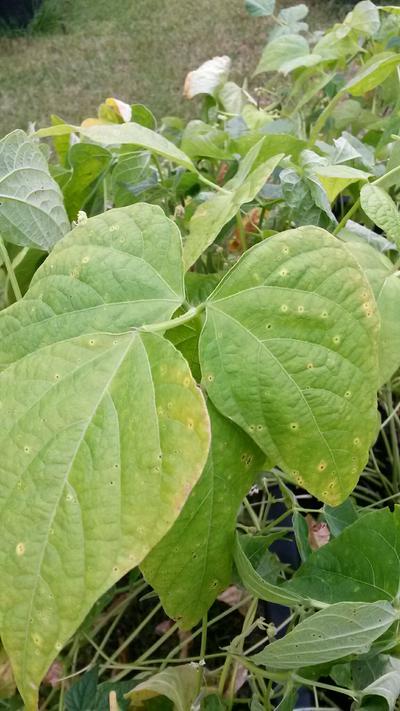Halo Blight
Pseudomonas savastanoi pv. phaseolicola
Bacteria
In a Nutshell
- Water-soaked spots on leaves.
- Surrounded by yellow-green halo.
- Center turns tan-colored.
- Water-soaked, dark green spots or streakes on pods.
- Greasy appearance.
Can also be found in
Symptoms
Small, irregular water-soaked spots first appear on leaves, often on the lower surface. The spots do not enlarge significantly with the progression of the disease but they start to develop on the upper leaf blade. A broad, chlorotic, yellow-green halo surrounds these spots. Under warm, dry conditions, the tissue in the center of the spot turns tan-colored and necrotic, while the halos become less visible. Leaves of plants infected at early stages become curved and chlorotic but do not necessarily show the typical symptoms. The pods show water-soaked, dark green spots or streaks along the sutures that can turn brown after humid, rainy weather. After several days of growth bacterial fluid gives the spots on leaves and pods a greasy appearance.
Recommendations

Organic Control
Extracts of Lupinus albus, L. luteus or garlic show some bactericidal effect against P. savastanoi pv. phaseolicola. Erwinia herbicola applied to seeds also inhibits the growth of the bacteria.

Chemical Control
Always consider an integrated approach with preventive measures together with biological measures if possible. Seeds can be treated with an authorized antibiotic to reduce contamination. Applying copper-based sprays during late vegetative stages will also provide some control.
What caused it?
Pseudomonas syringae pv. phaseolica is a pathogen that overwinters on seeds and plant residues in the soil. It needs plant tissue to survive. Primary infection occurs during wet weather when splashing water and blowing soil carries it onto the leaves. The transmission is favored by injuries to the plant during rainstorms, hail or during field work. Cool weather (around 20°C) enhances pathogen development and the release of a toxin (phaseolotoxin) that triggers the characteristic symptoms in plants. Temperatures over 25°C inhibit the formation of the halo. The infection leads to reduction in plant productivity, fruit yield and quality.
Preventive Measures
- Use seeds from a certified pathogen-free source.
- Plant resilient varieties.
- Use fortifiers for a general strengthening of the plants.
- Avoid mechanical damage during cultivation.
- Use furrow or drip irrigation systems.
- Do not work in the field while the foliage is wet.
- Eliminate weeds and volunteer beans plants.
- Plow deep plant debris after harvest to favor decomposition.
- Rotate with non-host crops for at least two years.
- Do not use infected bean straw as mulch.



